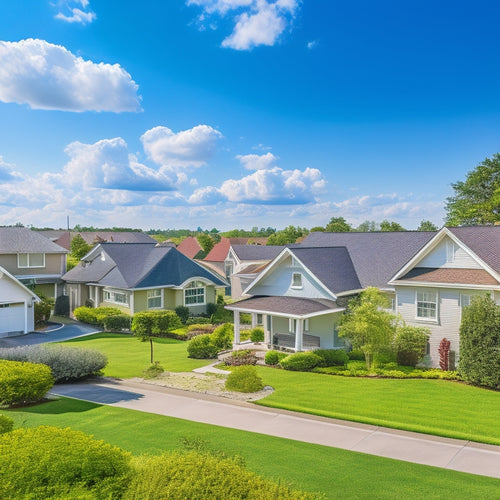
DIY: Install Solar Security Lights for Sustainable Homes
Share
You're taking a significant step towards a more sustainable home by deciding to install solar security lights, which can provide substantial cost savings, reduce your carbon footprint, and enhance safety and security around your property. To get started, you'll need to choose the right solar lights based on factors like brightness, durability, and energy efficiency. Next, prepare for installation by gathering necessary tools and reviewing the manufacturer's instructions. Properly orient and mount the solar panels, and then install the light fixtures. As you move forward, you'll want to verify you're maximizing your system's efficiency and troubleshooting any issues that arise - and there's more to investigate to make the most of your new solar security lights.
Key Takeaways
- Choose the right solar lights considering factors like brightness, durability, and energy efficiency to ensure effective security and sustainability.
- Ensure proper orientation of solar panels to maximize energy harvesting, typically south-facing at 30-45 degrees with seasonal adjustments.
- Mount solar light fixtures at optimal locations, considering visibility, accessibility, and potential obstructions, and secure them properly.
- Follow a regular maintenance routine for solar light batteries, including cleaning terminals, checking water levels, and replacing them as needed.
- Troubleshoot common issues by inspecting solar panels, adjusting settings, and replacing batteries to ensure continuous operation of solar security lights.
Benefits of Solar Security Lights
Solar security lights offer a multitude of benefits that make them an attractive option for homeowners and businesses alike.
You'll appreciate the significant cost savings, as they utilize free energy from the sun, reducing your reliance on traditional power sources. This, in turn, minimizes your environmental impact, making them an eco-friendly choice.
Additionally, solar security lights require minimal maintenance, as they've fewer moving parts and no wiring to worry about. By achieving energy independence through solar energy utilization sustainable infrastructure, you can future-proof your property and support corporate sustainability goals.
You'll also enjoy the increased safety and security they provide, as they can be installed in areas where traditional lighting may be difficult or expensive to install.
Choosing the Right Solar Lights
When selecting solar security lights, you're faced with a multitude of options, and it's vital to take into account several key factors to confirm you get the right fit for your specific needs.
You'll need to evaluate the type of solar light that suits your requirements, such as floodlights, spotlights, or pathway lights. Light brightness is another important factor, measured in lumens (lm). Verify the solar lights you choose provide sufficient brightness to illuminate the desired area. For instance, a 200-300 lm solar light is suitable for small areas, while 500-700 lm is needed for larger spaces.
Additionally, assess the solar panel's wattage, battery capacity, and IP rating to guarantee durability and weather resistance. It's also essential to take into account the energy efficiency features of the solar lights, such as high-efficiency photovoltaic cells and low-temperature coefficients, which contribute to stable performance and reduced carbon footprints.
In addition, look for solar lights from reputable brands, such as Renogy, WindyNation, and HQST, which focus on high solar efficiency and durability.
Pre-Installation Preparation Checklist
You've chosen the perfect solar security lights for your sustainable home, now it's time to prepare for installation. Before you begin, make certain you have the necessary installation tools, including a drill, screws, and a level.
Familiarize yourself with the solar panel types you're working with, whether they're monocrystalline, polycrystalline, or thin-film. Consider the importance of high-efficiency solar panels in maximizing energy yield, and guarantee your panels are optimized for seasonal changes.
Check the manufacturer's instructions for specific installation requirements. Clear the area where you'll be installing the lights, removing any debris or obstructions. Ensure a stable and secure mounting surface, and consider any local building codes or regulations.
Installing Solar Light Panels
When installing solar light panels, you'll need to evaluate the ideal orientation to maximize energy harvesting, as even slight misalignments can impact performance.
High-efficiency solar panels can maximize energy output, reducing space requirements high-efficiency solar panels, and scalable solar systems with modular design can accommodate varying energy needs.
You'll also need to choose a suitable mounting option, whether it's a roof-mounted, wall-mounted, or pole-mounted setup, to guarantee secure and durable installation.
Panel Orientation Matters
Properly orienting your solar light panels is vital to utilizing maximum energy from the sun. When installing solar panels, you'll need to take into account the type of panel you're using and its ideal orientation.
For instance, industry-leading brands like SunPower and Panasonic offer high-efficiency panels with customizable kits that can be customized to meet specific energy needs. For example, monocrystalline solar panels are more efficient than polycrystalline panels, but they're also more expensive.
Regardless of the type, you'll want to position your panels at an angle that allows them to receive direct sunlight for most of the day. This typically means facing them south, with a tilt between 30 and 45 degrees.
Regular solar panel maintenance is also essential to guarantee peak energy production. Clean your panels regularly to remove debris and dirt that can reduce their efficiency.
Mounting Options Available
With your solar light panels positioned at the ideal angle, it's now time to secure them in place.
You'll need mounting brackets specifically designed for solar panels to guarantee a sturdy installation. These brackets usually come with wall anchors, which provide additional stability to the setup.
When choosing a mounting bracket, consider the type of surface you're installing on - whether it's a roof, wall, or pole. Make certain the bracket is compatible with your solar panel's dimensions and is rated for outdoor use.
Follow the manufacturer's instructions to attach the bracket to the wall anchor, and then secure the solar panel to the bracket. A secure installation will guarantee your solar security lights function efficiently and safely.
Efficient Energy Harvesting
Positioned at the ideal angle, your solar light panels are now ready to capture energy from the sun.
With advanced solar panel technology, you can maximize energy collection during peak sunlight hours. This energy is then stored in the battery through efficient energy storage systems, ensuring a reliable power source for your security lights.
As you angle your panels correctly, you'll optimize energy absorption, reducing the likelihood of power outages. Regular maintenance, including cleaning, is essential for solar panel performance and energy efficiency, which can prevent up to 25% energy loss.
By utilizing the sun's energy, you're not only reducing your carbon footprint but also gaining independence from traditional energy sources.
With efficient energy collection, you can enjoy sustainable and reliable security lighting, giving you peace of mind and freedom from energy constraints.
Mounting Solar Light Fixtures
When mounting solar light fixtures, you'll need to choose locations that provide ideal coverage and guarantee the fixtures are securely fastened to withstand outdoor elements.
Contemplate integrating solar-powered charging solutions renewable energy sources to reduce your carbon footprint and energy costs.
You'll want to reflect on factors like visibility, accessibility, and potential obstructions when selecting mounting locations.
Properly securing light fixtures involves choosing the right type of hardware and following the manufacturer's instructions to prevent damage or theft.
Choosing Mounting Locations
Three key areas to focus on when choosing mounting locations for your solar security lights are visibility, accessibility, and proximity to potential intruders.
You want to make certain your lights are installed at ideal heights to maximize their effectiveness, usually between 6-10 feet off the ground. This allows for a clear view of the surrounding area while minimizing the risk of tampering.
Consider environmental factors, such as avoiding areas with heavy tree coverage or nearby structures that could obstruct sunlight.
Additionally, think about the layout of your property and where intruders are most likely to enter.
Securing Light Fixtures Properly
Beyond the strategic planning phase, it's now vital to focus on the tangible aspect of securing your solar security lights: physically mounting them.
You'll need to choose the right securing method based on the type of light fixture you've selected. For instance, surface-mounted fixtures typically require screws or adhesive, while recessed fixtures need a more complex installation process.
Make certain to follow the manufacturer's instructions for specific securing methods. Additionally, consider the material of your home's exterior, as this may impact the type of securing method you use.
Wiring and Connecting Lights
As you prepare to wire and connect your DIY solar security lights, make sure you have all the necessary components within arm's reach, including the solar panel, battery, charge controller, and LED lights.
Now, it's time to apply wiring techniques to connect the circuits. This vital step requires attention to detail to guarantee safe and efficient energy flow.
-
Connect the solar panel to the charge controller, following the manufacturer's instructions.
-
Link the charge controller to the battery, confirming correct polarity.
-
Attach the battery to the LED lights, using appropriate wiring and connectors.
-
Verify all connections are secure and insulated to prevent electrical shock.
-
Double-check the entire circuit for any signs of wear or damage before turning on the lights.
Solar Light Battery Maintenance
Each DIY solar security light system relies heavily on its battery's performance, making regular maintenance essential to guarantee ideal energy storage and longevity. You'll want to confirm your battery lasts as long as possible, and with proper care, you can extend its lifespan.
| Task | Frequency |
|---|---|
| Regular cleaning of terminals and connections | Every 3 months |
| Checking water levels (if applicable) | Every 6 months |
| Deep cycle battery charging | Every 12 months |
Troubleshooting Common Issues
You've successfully installed your DIY solar security lights, but now you're facing some issues.
If your light isn't turning on, the battery isn't charging, or the sensor isn't working, don't worry - these common problems are often easy to fix.
Let's walk through some troubleshooting steps to identify and resolve these issues.
Light Not Turning On
Faulty solar security lights can be frustrating, especially when they refuse to turn on.
You've invested time and effort into installing them, and now they're not performing as expected.
Don't worry, we've you taken care of. Here are some common issues to check:
-
Dirty or dusty solar panels: Clean the panels to guarantee they're receiving sufficient sunlight.
-
Incorrect light sensitivity settings: Adjust the settings to match your environment's lighting conditions.
-
Loose or damaged connections: Inspect the connections between the solar panel, battery, and light.
-
Dead or weak batteries: Replace the batteries if they're old or worn out.
-
Obstruction or shading: Verify the solar panel isn't obstructed by trees, buildings, or other objects.
Battery Not Charging
Most solar security lights rely on batteries to store energy generated by the solar panel, making them a critical component.
If your solar security light's battery isn't charging, it may be due to a faulty solar panel or a dead battery. Check the solar panel for debris or damage, ensuring it's clean and unobstructed.
If the issue persists, inspect the battery connections for corrosion or loose wires. You may need to replace the battery, considering the battery lifespan, which typically ranges from 3 to 5 years.
Be aware of the solar battery types, such as lead-acid or lithium-ion, as they've different charging requirements. Consult your manufacturer's instructions for specific guidance.
Sensor Not Working
Set up your solar security light to optimize its sensor's performance. If you're experiencing sensor issues, don't worry - troubleshooting is straightforward.
Here are some common causes and solutions:
-
Dirty or obstructed sensor: Clean the sensor and verify it's not blocked by objects or debris.
-
Incorrect sensor angle: Adjust the sensor to face the desired direction and angle.
-
Insufficient power: Check the battery level and recharge it if necessary.
-
Sensor sensitivity: Adjust the sensitivity setting to suit your environment.
-
Faulty sensor: Replace the sensor if none of the above troubleshooting methods work.
Advantages of Wireless Solar Lights
Three key benefits of wireless solar lights make them an attractive option for homeowners seeking to enhance their outdoor security.
You'll enjoy cost savings since they're free from electrical wires, eliminating the need for digging and trenching. This translates to no utility bills and reduced maintenance costs.
Furthermore, wireless solar lights are an eco-friendly option, utilizing renewable energy from the sun to power your security system. This means you'll reduce your carbon footprint while illuminating your outdoor spaces.
With wireless solar lights, you'll have the freedom to install them anywhere, without worrying about proximity to power outlets or electrical connections.
Maximizing Solar Light Efficiency
You've chosen wireless solar lights for their convenience and eco-friendliness, but to get the most out of them, it's vital to optimize their energy harvesting and storage capabilities.
Proper solar panel placement is important, as it directly affects energy generation. Make certain your solar panels face south and are angled to match your location's latitude.
To maximize efficiency, consider the following:
- Optimize light intensity by adjusting the sensitivity of the motion sensor or timer settings.
- Clean the solar panels regularly to maintain their energy-absorbing capacity.
- Trim nearby trees or shrubs to minimize shading.
- Use energy-efficient LED lights to reduce power consumption.
- Install a battery with a high depth of discharge (DOD) to maximize storage capacity.
Frequently Asked Questions
Can I Install Solar Security Lights on a Metal Roof?
You can install solar security lights on a metal roof, but guarantee proper metal roof installation and secure solar light placement using specialized clips or brackets to withstand wind and weather conditions.
Will Solar Lights Still Work During a Power Outage?
When the grid goes dark, you're not left in the dark: solar lights will shine on, utilizing the sun's energy like a guiding light of freedom. Since they're self-sufficient, you'll enjoy power autonomy, unaffected by outages, thanks to their solar efficiency.
Do Solar Lights Require Any Special Permits or Licenses?
You'll need to check local solar panel regulations and installation guidelines before setting up your solar lights, as permits or licenses may be required, ensuring compliance with authorities while maintaining your independence and freedom.
Can I Use Solar Lights With Existing Security Systems?
While enjoying the freedom from grid-tied systems, you're wondering if solar lights can integrate with existing security setups; fortunately, compatibility concerns are minimal, and with proper installation tips, you can seamlessly merge them, expanding your sustainable haven.
Are Solar Security Lights Suitable for Areas With Heavy Snowfall?
You'll find solar security lights suitable for areas with heavy snowfall if you prioritize winter maintenance, such as cleaning snow from panels, to guarantee optimal solar panel efficiency, granting you the freedom to illuminate your space sustainably.
Related Posts
-

What Cool Roof Tax Breaks Can Homeowners Claim?
You can claim federal tax credits of up to $500 and state and local incentives for installing cool roofs, which not o...
-

5 Ways Geothermal Power Boosts Electric Vehicle Efficiency
You're likely unaware that geothermal power can greatly enhance your electric vehicle's (EV's) performance, range, an...
-

7 Blockchain Tools for Home Energy Management
You can utilize blockchain technology to optimize your home's energy management through innovative solutions like blo...


